148 Kuwait

Three equal horizontal bands of green (top), white, and red with a black trapezoid based on the hoist side. Colors and design are based on the Arab Revolt flag of World War I. Green represents fertile fields, white stands for purity, red denotes blood on Kuwaiti swords, black signifies the defeat of the enemy.
Flag courtesy of the CIA World Factbook
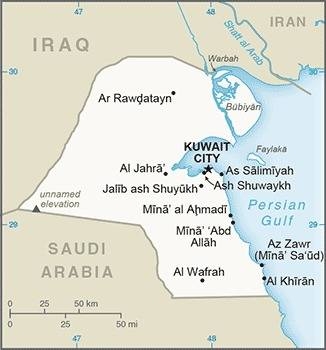
Map courtesy of the CIA World Factbook

The Kuwait Water Towers: “Mushrooms in the Desert.” There are actually 31 of these aesthetically pleasing water towers in Kuwait City; they were completed in 1976.
Photo courtesy of the CIA World Factbook
Government
According to Britannica, Kuwait is a constitutional monarchy with one legislative body. Since gaining independence from Britain in 1961, Kuwait has been governed by an emir from the Ṣabāḥ family. The emir rules through a Council of Ministers, consisting largely of members of his own family, that he himself appoints. Legislative power rests in the National Assembly (Majlis al-Ummah), whose 50 members are elected to four-year terms. This parliament, however, also includes appointed cabinet ministers and has been dissolved several times, including in 1976, 1985, 1999, 2006, and 2009.
Kuwait’s legal system has several sources. Personal and civil law (roughly, family law and probate law) are based largely on Sharīʿah (Islamic law). Commercial and criminal law, while also influenced by Sharīʿah, borrows heavily from both European civil and common law as well as from the legal codes of the Ottoman Empire and from those of other Arab states, which are themselves heavily influenced by European law. There are several lower courts and a system of appeals courts. The emir sometimes acts as the final court of appeal.
Civil / National Aviation Authority (CAA/NAA)
In 1956, Kuwait Civil Aviation Department is established as a section of the Directorate of Public Security (later renamed the Ministry of Interior). Two years later Kuwait Airport reports directly to the Civil Aviation Department. Civil Aviation Department decrees Objectives and Aviation Affairs Policy. In 1960, the State of Kuwait becomes a signatory to the International Civil Aviation Chicago Agreement. Kuwaiti business magnates establish private airline Trans Arabia Airways. Announcement of Law No. 30 for organizing Civil Air Navigation, and Law No. 37 for Organizing Aircraft Accidents Investigation. Issue of Amiri Decree inaugurating the Supreme Council of Civil Aviation to handle policy matters relating to the Civil Aviation sector takes place in 1963. Kuwait becomes a full member of both ICAO and World Meteorology Organization (WMO).
Airspace
SkyVector – Google Maps – ADS-B Exchange
ICAO countries publish an Aeronautical Information Publication (AIP). This document is divided into three parts: General (GEN), En Route (ENR) and Aerodromes (AD). ENR 1.4 details the types of airspace classes they chose to adopt from classes A through G. Kuwait AIP – password required
Drone Regulations
REGULATORY CIRCULAR (NO. 2019-34)
Subject: Notice of Amendment to Kuwait Civil Aviation Safety Regulations KCASR (issue 4).
Purpose: The purpose of this Regulatory Circular No. 20L9-34 is to introduce KCASR 22 – Unmanned Aircraft Systems (UAS) (issue 4) . This Regulatory Circular No. 2019-34is based on (NPA) No.2018-40 dated on77/Oct/2018.
Revisions: This amendment will be included in revision (0) of KCASR 22 – Unmanned Aircraft Systems (uAS).
Regulatory Requirements: This amendment shall apply to the following Organizations approved by the Directorate General of Civil Aviation (DGCA) or authorized to operate within the State of Kuwait:
1. Approved Maintenance Organizations (AMO) Holders;
2. Air Navigation Service Providers;
3. Air Operator Certificate (AOC) & Private Operator Certificate (POC) Holders;
4. Airport Operators;
5. Ground Handling Service Providers;
6. Flying Training Organizations;
7. All users of KCASRs.
Effective Date: This new revision will be in effect from (05/Jan/2020).
Required Action: AII users of KCASR are required to comply with the provisions contained within this amendment from the effective date.
Kuwait DGCA may delegate part or all of this regulation implementation to an entity approved by Kuwait DGCA. That entity shall remain under the oversight of Kuwait DGCA, and shall insure full compliance with relevant KCASRs parts. Delegation may include but not limited to:
1- Registration,
2- Training,
3- Assessment,
4- Issuing Unmanned Pilot license,
5- Maintaining and renewal of the Unmanned Pilot license,
6- Fees collection.
Fees, Enforcement and Sanctions: Refer to KCASR 26 and KCASR 27.
Scope – Unless authorized to operate an Unmanned Aircraft System (UAS) by the Kuwait DGCA in accordance with this regulation, no person or organization shall operate an Unmanned Aircraft System (UAS)/Drone within Kuwait Flight Information Region (FIR) for:
A. Recreational operations (Category A)
B. Professional operations (Category B)
C. Special Operations (Category C)
Guidance Material (GM1) Scope – The authorization issued by Kuwait DGCA may take the form of an UAS Operator Certificate (UOC) or a validation of their UOC or equivalent.
Guidance Material (GM2) Scope – Recreational Operation category (A) includes operation of UAS for use for sport or hobby. Non-commercial operations category (B1) include operation of an UAS by government entities, or by commercial entities conducting demonstration flights with the intent to sell or rent the UAS or to conduct flights for its own benefits and not for remuneration or hire. The following activities, but not limited to, should fall under category (B2) commercial operations:
a.Media
b.Survey
c.Surveillance
d.Inspection
e.Air delivery
f. Technical services
g.Manufacturing
Guidance Material (GM3) Scope – Categories of UAS Operations UAS operations shall fall into one of the following three risk-based categories:
A. Category (A), UAS used for recreational operations, and is further subdivided into 3 categories depending on the max take-off mass
1) Category (A1), UAS with max take-off mass < 300g (0.5 kg)
2) Category (A2), UAS with max take-off mass > 300g (0.5 kg) and < 5 kg
3) Category (A3), UAS with max take-off mass > 5.01 kg and < 25 kg
B. Category (B), UAS used for Professional operations of UAS max take-off mass less than 150 kg and is further subdivided into 2 categories depending on type of operations.
1) Category (B1) non-commercial operations (0 to 150 Kg)
2) Category (B2) commercial operations (0 to 150 Kg)
C. Category (C), UAS used for Special operations of max take-off mass Above 150 kg.
Alternative Means of compliance
1. Alternative means of compliance to those adopted by the Kuwait DGCA may be used by an operator to establish compliance with this Regulation.
2. When an operator subject to certification wishes to use an alternative means of compliance to the acceptable means of compliance (AMC) adopted by the Kuwait DGCA to establish compliance with this Regulation, it shall, prior to implementing it, provide the Kuwait DGCA with a full description of the alternative means of compliance. The description shall include any revisions to manuals or procedures that may be relevant, as well as an assessment demonstrating that the requirement is met. The operator may implement these alternative means of compliance subject to prior approval by the Kuwait DGCA and upon receipt of the notification.
3. Demonstration of Compliance. To demonstrate that a requirement is met, a risk assessment showing compliance should be completed and documented. The result of this risk assessment should demonstrate that an equivalent level of safety to that established by the AMC adopted by the Kuwait DGCA is achieved.
Abbreviations and definitions
For the purposes of this Regulation, the following abbreviations and definitions apply:
A.Abbreviations
(1) MOI: Ministry of Interior
(2) MOC: Ministry of Communication
(3) UAS: Unmanned Aircraft System (Drone)
(4) VLOS: Visual Line of Sight
(5) EVLOS: Extended Visual Line ofSight
(6) RC: Remote Control
B.Definitions
(1) Autonomous UAS: An operation during which an UAS is operating without intervention of a human-being in the management of the flight.
(2) Commercial operation: An UAS operation conducted for business purposes (mapping, security surveillance, wildlife survey, aerial application, etc.) other than commercial air transport, for remuneration or hire.
(3) Congested area: any area of a city, town or settlement which is substantially used for residential, industrial, commercial or recreational purposes.
(4) Controlled airspace: An airspace of defined dimensions within which air traffic control service is provided in accordance with the airspace classification.
(5) Drone: Dynamic Remotely Operated Navigation Equipment.
(6) EVLOS operation: An operation in which the UAS Operating Crew maintains indirect visual contact with the UAS using screen to manage its flight and meet separation and collision avoidance responsibilities.
(7) Geofencing: An automatic function to limit the access of the UAS to airspace areas or volumes provided as geographical limitations based on the UAS position.
(8) Non-segregated Airspace: Any airspace other than segregated airspace.
(9) Novel Technology: is a new technology that has never been used on an UAS. The technology may be used as payload or built in for the operation of the UAS.
(10) Operational Control: The exercise of authority over the initiation, continuation, diversion or termination of a flight in the interest of safety.
(11) Operator: An organization engaged in the operation other than for recreational, of an UAS.
(12) Operations Manual: A manual that contains procedures, instructions and guidance for use by UAS operational personnel in the execution of their duties.
(13) Populous area: The area that has a sufficient density of population for some aspect of the operation, or some event that might happen during the operation (in particular, a fault in, or failure of, the UAS) to pose an unreasonable risk to the life, safety or property of somebody who is in the area but is not connected with the. operation.
(14) Prohibited area: An airspace of defined dimensions, above the land areas or territorial waters of a State, within which the flight of aircraft is prohibited.
(15) Remote control (RC): may be referred to as Unmanned Aircraft System (UAS): An aircraft and its associated elements which are operated with no pilot on board. An UAS may be remotely piloted (i.e. RPAS) or autonomously piloted (i.e. Autonomous UAS).
(16) Recreational UAS: Recreational or hobby UAS use means flying for enjoyment and not for work, business purposes, or for compensation or hire.
(17) Restricted area: An airspace of defined dimensions, above the land areas or territorial waters of a State, within which the flight of aircraft is restricted in accordance with certain specified conditions.
(18) Segregated Airspace: Airspace of specified dimensions allocated for exclusive use to specific user(s).
(19) Sense and avoid: The capability to see, sense or detect conflicting traffic or other hazards and take the appropriate action
(20) Unmanned Aircraft System (UAS): An aircraft and its associated elements which are operated with no pilot on board. An UAS may be remotely piloted (i.e. RPAS) or autonomously piloted (i.e. Autonomous UAS).also Known as (Drone)
(21) UAS Crew Member: Any personnel involved in an UAS operations (flying crew, observer, etc.)
(22) UAS Operator Certificate (UOC): A certificate authorizing an operator to carry out specified operations other than recreational with an UAS.
(23) UAS Operating Crew Member: The person who manipulates the flight controls of a UAS during flight time.
(24) Visual Meteorological Conditions (VMC): Meteorological conditions expressed in terms of visibility, distance from cloud, and ceiling, equal to or better than specified minima.
(25) Vicinity of an aerodrome: Any area as specified in KCASR 14.
(26) VLOS operation: An operation in which the UAS Operating Crew maintains direct visual contact with the UAS to manage its flight and meet separation and collision avoidance responsibilities.
Competent Authority
Kuwait Directorate General of Civil Aviation Authority (Kuwait DGCA) shall grant certification / licensing under this regulation to the UAS Operators / users.
Application for an UOC or validation of a foreign UOC or equivalent
A. The application for an initial UOC, renewal of an UOC or validation of a foreign UOC or equivalent shall be made in a form and manner established by Kuwait DGCA.
B. An Applicant for an initial UOC shall provide Kuwait DGCA with documentation demonstrating how compliance with the requirements established in this Regulation will be assured. Such documentation shall include a procedure describing how changes not requiring prior approval will be managed and notified to Kuwait DGCA. The operator shall provide the following information to the Competent Authority:
(1) The official name and business name, address, and mailing address of the applicant;
(2) The trade license or equivalent evidence of establishment;
(3) A description of the proposed operation, including the type(s), and number of UAS to be operated;
(4) A description of the management system, including organizational structure;
(5) The name of the Accountable Manager along with his/her qualifications;
(6) A copy of the Operations Manual required by item 8;
(7) A statement that all the documentation sent to Kuwait DGCA have been verified by the applicant and found in compliance with the applicable requirements;
(8) Security clearance for the organization (From MOI);
(9) Registration/Insurance certificate covering all operations;
(10) Evidences of qualification of all UAS Operating Crews;
(11) Declaration of compliance;
C. An Applicant for renewal of an UOC shall provide Kuwait DGCA with documentation demonstrating how compliance with the requirements established in this Regulation is assured. Such documentation shall include a declaration of compliance from the Accountable Manager.
D. An Applicant for validation of foreign UOC or equivalent shall provide Kuwait DGCA with documentation demonstrating how compliance with the requirements established in this regulation is assured. Such documentation shall include all data specified (B-1) to (B-11) above.
The validation issued by Kuwait DGCA shall not be renewable.
E. An applicant for an UOC or validation of a foreign UOC or equivalent shall demonstrate to Kuwait DGCA that:
(1) It complies with all the requirements of this REGULATION;
(2) The UAS is declared fit for the type of operation; and
(3) Its organization and management are suitable and properly matched to the scale and scope of the operation.
Acceptable Means of Compliance (AMC)
Application for an UOC or validation of a foreign UOC or equivalent
1. Application Time Frames. The application, using application form No.XXX4, for an UOC should be submitted at least 30 days before the intended start date of operation or expiry of the UOC. The Application shall include operation manual and all submission of administrative and security evidences such as Security Clearance or fee payment.
2. If the applicant does not hold a Kuwaiti trade license, Kuwait DGCA may accept a foreign Trade License along with any legal arrangement established with a locally based entity.
3. Declaration The intent of the declaration is to:
a) Have the operator acknowledges its responsibilities under the applicable safety regulations and that it holds all necessary approvals;
b) Inform Kuwait DGCA of the commitment of the operator to comply with the applicable regulations.
Guidance Material (GM1) – Application for an UOC or validation of a foreign UOC or equivalent UAS Operator Certificate (UOC) for UAS Operations categories
1) Category (A1) and (A2) UAS Operations are exempted from UOC application.
2) Category (A3), (B1), (B2) and (C) UAS Operations Shall apply for a UOC.
Operator responsibilities
The operator is responsible for the operation of the UAS in accordance with the relevant requirements of this regulation and its UAS Operator certificate (UOC).
The operator shall ensure that every flight is conducted in accordance with the provisions of the Operations Manual accepted by Kuwait DGCA and other applicable regulations or laws enforce.
The operator shall establish and maintain a system for exercising operational control over any flight operated under the terms of its UOC.
1. The operator shall ensure that all instruments and equipment required for a safe operation, for the area and type of operation are available and serviceable adequately.
2. The operator shall ensure that its UAS Operating Crews are of minimum age as per their relevant category, hold a Security Clearance and are qualified as required for the area and type of operation.
3. The operator shall ensure that all personnel assigned to, or directly involved in operations are properly instructed, have demonstrated their abilities in their particular duties, are aware of their responsibilities and the relationship of such duties to the operation as a whole, and remain sufficiently free from fatigue, alcohol, narcotic drug and any other substances which may impair their capacity to perform their duties to a satisfactory level of safety under all circumstances.
4. The operator shall establish procedures and instructions for the safe operation of each UAS, containing staff duties and responsibilities, for all types of operation. Those procedures and instructions shall not require crew members to perform any activities during critical phases of flight other than those required for the safe operation of the UAS.
5. The operator shall ensure that all personnel are made aware that they shall comply with the laws, regulations and procedures of Kuwait and that are pertinent to the performance of their duties.
6. The operator shall establish and provide UAS crew members with means to operate safely each UAS type in all phases of flight under normal, abnormal and emergency conditions and to ensure that the operating procedures in the Operations Manual are followed.
7. The operator shall specify procedures to provide for the safe conduct of the flight based on considerations of UAS performance, other operating limitations and relevant expected conditions to be followed and at the aerodromes or operating sites concerned. These procedures shall be included in the OperationsManual.
8. The operator shall not operate an UAS unless its design has been found acceptable to Kuwait DGCA and it has been registered with the Competent Authority.
9. The Operator shall ensure that no leasing of UAS is allowed unless approved by the Competent Authority.
Acceptable Means of Compliance (AMC1) operators’ responsibility
Operational Control The organization and methods established to exercise operational control should be included in the Operations Manual and should cover at least a description of responsibilities concerning the initiation, continuation and termination or diversion of each flight.
The operational control decided by the operator should be commensurate with the area flown and duration, severity and complexity of the operations.
The operational control should be robust to ensure safe flight in particular when the UAS flies autonomously.
Guidance Material (GM1) operators’ responsibility – The design and utilization of checklists should observe human factors principles and take into account the latest relevant documentation from the UAS manufacturer.
Acceptable Means of Compliance (AMC2) operators’ responsibility – Each UAS should be equipped with navigation lights to signal the UAS position and attitude or any other instruments or equipment required for safe navigation in normal, abnormal, emergencies situations and during day and night. This includes the equipment required to ensure compliance with the terms of approval of the operator.
Guidance Material (GM2) operators’ responsibility
1. Prior to the commencement of each flight, the operator should determine the autonomy required by the intended operations and configure the UAS accordingly to allow a safe return to the landing area or elsewhere if the autonomy becomes critical. The determination of autonomy should consider all identified hazards that may require additional power (e.g. adverse weather).
2. The management of fatigue should consider the fatigue accumulated over successive flights or successive duties with information to the UAS operating personnel that no flight should be undertaken if he/she knows or suspects that he/she is suffering from fatigue, or feels unfit to the extent that the flight may be endangered. The fatigue management system should establish a rest period scheme for UAS operating crew members in accordance with the size and the complexity of its operation. The rest period scheme may be described in the operational manual (OM).
3. A check list is a means allowing a UAS crew member to maintain control over the UAS during any planned and unplanned situations / conditions. If a checklist is not suitable, the UAS crew member must be instructed to maintain apply his/her judgment and applies best practices to ensure that the UAS does not act as an object that may endanger a property, an individual, another aircraft or collide with objects.
Acceptable Means of Compliance (AMC3) operators’ responsibility
UAS Design Standers The UAS should meet standards recognized by Kuwait DGCA and should be equipped with:
(a) a direct radio control link within the Frequency Band (29.7-47.0 MHz) with maximum power of 10 mW or (2400-2500 MHz) with maximum power of 100 mW or any other band allocated by the Ministry of Communication (MOC);
(b) a Geo-fencing feature using GPS technology;
(c) a Fail-Safe (Return Home/Hover) device;
(d) a sense and avoid function and a transponder in the event of special approval to operate in controlled airspace; and
(e) any other equipment required to ensure safe operation in the concerned airspace (e.g. if airspace required Transponder, then the UAS must be equipped with a Transponder if operating in nonsegregated airspace).
The operator of an UAS/Drone in categories (A2), (A3), (B1), (B2) and (C) shall register with the Kuwait DGCA or with a service provider designated by Kuwait DGCA and display registration or membership marks on all the UAS/Drone it operates for them to be easily identifiable, when required by Kuwait DGCA or MOI.
Acceptable Means of Compliance (AMC) – UAS REGISTRATION
A. Registration process shall be submitted to Kuwait DGCA through Kuwait DGCA web Site;
B. Form no. xxx1 shall be filled by category (A3) operator and stamped by relevant Insurance Organization. (GM UAS registration table 1);
C. Form no. xxx2 shall be filled by category (B) operator and stamped by relevant Insurance Organization. (GM UAS registration table 1);
D. Form no. xxx3 shall be filled by category (C) operator and stamped by relevant Insurance Organization. (GM UAS registration table 1);
E. Insurance Policy (Table 1).
F. The Insurance Organization will maintain records of all registered UAS/ Drones;
G. For the purpose of advanced sport activity category (A3), the operator shall submit to Kuwait DGCA proof of registration with an approved flying club or equivalent. (GM UAS registration table 1);
H. All operation categories shall also apply for an UOC with exception of Recreational operator categories (A1) and (A2). (GM UAS registration table 1);
Guidance Material (GM) – UAS REGISTRATION
Table 1.

Terms of approval and privileges of an UOC holder
1. An operator shall comply with the scope and privileges defined in the UOC and associated specifications and limitations (i.e. Terms of approval).
2. At minimum, the following limitations shall apply to any operation undertaken by an operator unless otherwise authorized by the Competent Authority:
a) Operations shall be limited to day time;
b) Operations shall be limited to VMC conditions;
c) Operations shall be limited to VLOS operations;
d) Operations shall be limited to height above the ground as per their respective categories (table 2)
e) Operations shall be limited to a maximum horizontal distance of 150m from the UAS Operating Crew Member or launching site whichever is greater;
f) Operations shall be limited to UAS with a maximum take-off mass as per their respective categories. (GM2 UOC Holder Table 2)
g) Operations in areas authorized by Kuwait DGCA; and
h) Any other conditions imposed for the interest of safety or liability by any other agencies.
Acceptable Means of Compliance (AMC1) – UOC Holder
A. Management system Documentation. The management system documentation should contain the privileges and detailed scope of activities for which the operator is certified, as relevant to the applicable requirements. The scope of activities defined in the management system documentation should be consistent with the terms of approval.
Guidance Material (GM1) – UOC Holder
The operator should determine the autonomy required by the intended operations prior to the commencement of the flight and configure the UAS accordingly to allow a safe return to the landing area or elsewhere if the autonomy becomes critical. The determination of autonomy should consider all identified hazards that may require additional power (e.g. adverse weather).
Guidance Material (GM2) – UOC Holder
Table 2
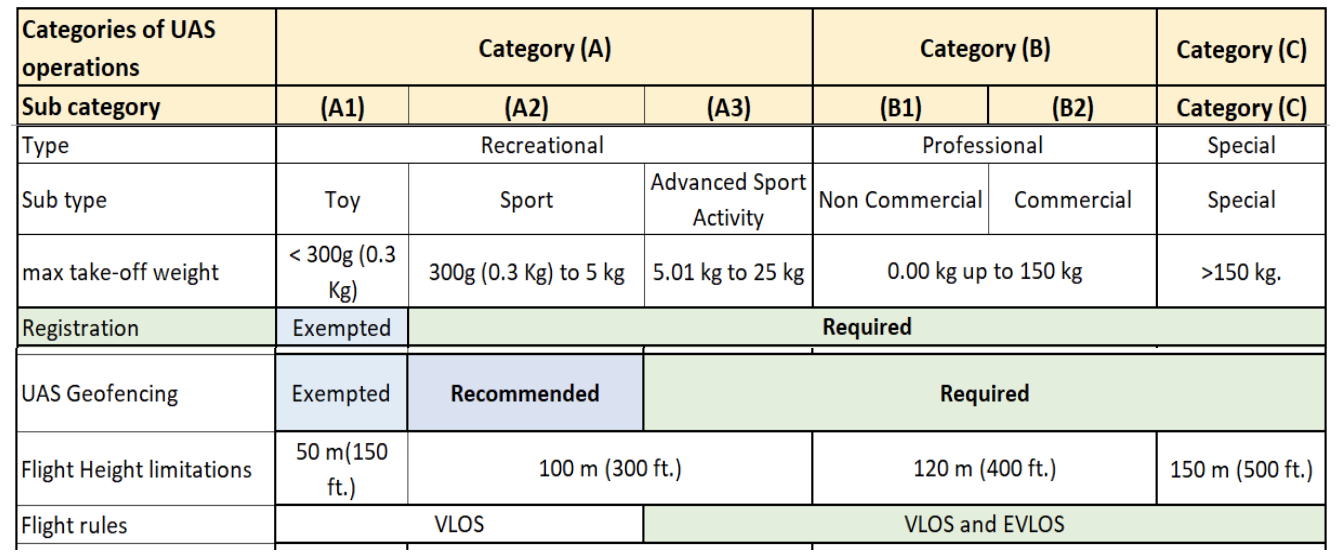
Operations Manual (OM)
A. The operator shall be capable of distributing operational instructions and other information without delay.
B. The operator shall establish an Operations Manual (OM) for the use and guidance of UAS operations personnel.
C. The content of the OM shall reflect the requirements set out in this regulation and shall not contravene the conditions contained thereof and any other set by Kuwait DGCA.
D. All UAS/Drone operating personnel shall have easy access to the portions of the OM that are relevant to their duties.
E. The OM shall be kept up to date. All personnel shall be made aware of the changes that are relevant to their duties.
F. Each member shall be provided with a personal copy of the relevant sections of the OM pertaining to their duties. Each holder of an OM, or appropriate parts of it, shall be responsible for keeping their copy up to date with the amendments or revisions supplied by the operator.
G. Amendments:
(1) The operator shall supply Kuwait DGCA with intended amendments in advance of the effective date; and
(2) For amendments to procedures associated with prior approval items, approval shall be obtained before the amendment becomes effective.
H. Notwithstanding (I), when immediate amendments or revisions are required in the interest of safety, they may be published and applied immediately, provided that any approval required has been applied for.
I. The operator shall incorporate all amendments and revisions required by Kuwait DGCA.
J.The operator shall ensure that information taken from approved documents, and any amendment thereof, is correctly reflected in the OM. This does not prevent the operator from publishing more conservative data and procedures in the OM.
K. The operator shall ensure that all personnel are able to understand the language in which those parts of the OM which pertain to their duties and responsibilities are written. The content of the OM shall be presented in a form that can be used without difficulty.
Acceptable Means of Compliance (AMC) Operations Manual (OM)
The content of the Operational Manual can be contained in one single manual or divided into several manuals.
The Operations Manual (OM) may vary in detail according to the complexity of the operation and of the type and number of UAS operated.
The main structure of the OM may
A. General:
(a) Compliance statement signed by the Accountable Manager
(b) a list and description of all sections in theOperations Manual;
(c) administration (function and management);
(d) responsibilities (all management and administrative staff);
(e) approval or authorization of flights;
(f) responsibilities of the UAS CrewMembers;
(g) carriage of payload;
(h) UAS documentation;
(i) retention of documents;
(j) UAS Operating Crew qualification records;
(k) flight time limitations
(l) flight hours logbooks;
(m) safety (general): equipment, radio listening watch, hazards, accidents and incidents (including reports), etc.
B. Technical:
(a) aircraft handling (including checklists, limitations, maintenance in accordance with relevant requirements, etc.);
(b) emergency procedures.
C. Route:
(a) performance (legislation, take-off, route, landing, etc.);
(b) flight planning (fuel, oil, battery, minimum safe altitude, etc.);
(c) loading (mass, balance and limitations);
(d) weather minima be as follows:
(1) flying zones.
(2) Take-off / landing areas.
D. Training, comprising all training instructions for UAS CrewMembers required for a safe operation.
(a) The OM or parts thereof may be presented in any form, including electronic form. In all cases, the accessibility, usability and reliability should be assured.
(b) The OM should be such that:
(1) All parts of the manual are consistent and compatible in form and content;
(2) The manual can be readily amended; and
(3) The content and amendment status of the manual is controlled and clearly indicated.
(c) The OM should include a description of its amendment and revision process specifying:
(1) The person(s) who may approve amendments or revisions;
(2) The conditions for temporary revisions and/or immediate amendments or revision required in the interest of safety; and
(3) The methods by which operator personnel are advised of the changes.
(4) When compiling an OM, the operator may take advantage of the contents of other relevant documents. Material produced by the operator for the UAS-related part of the OM may be supplemented with, or substituted by, where such a document exists, by an UAS operating manual produced by the manufacturer of the UAS.
Special Approvals
An operator may be granted a Special Approval by Kuwait DGCA for the following operations after demonstration of its capabilities to ensure safe operations:
(a) To conduct night VMC operations within VLOS;
(b) To conduct flights with Altitudes above their respective categories;
(c) To operate anUAS: (GM2 Special Approvals table 3)
(1) with a maximum take-off mass of more than their respective categories; or
(2) equipped with novel technology;
(d) To conduct operations over:
(1) congested or populous area;
(2) restricted area or controlled airspace; or
(3) segregated airspace.
(e) To conduct flights beyond VLOS or beyond their respective categories horizontal distance from the UAS Operating Crew Member or launching site whichever is greater;
(f) To conduct flights with less than 50 m from a person and a fixed or mobile object (GM2 Special Approvals table 3)
Guidance Material (GM1) Special Approvals
a) An application for airspace approval should be submitted to Kuwait DGCA.
b) A novel technology may be on the equipage, the payload or on the means the UAS is commanded and controlled from the ground.
Guidance Material (GM2) Special Approvals
Table 3
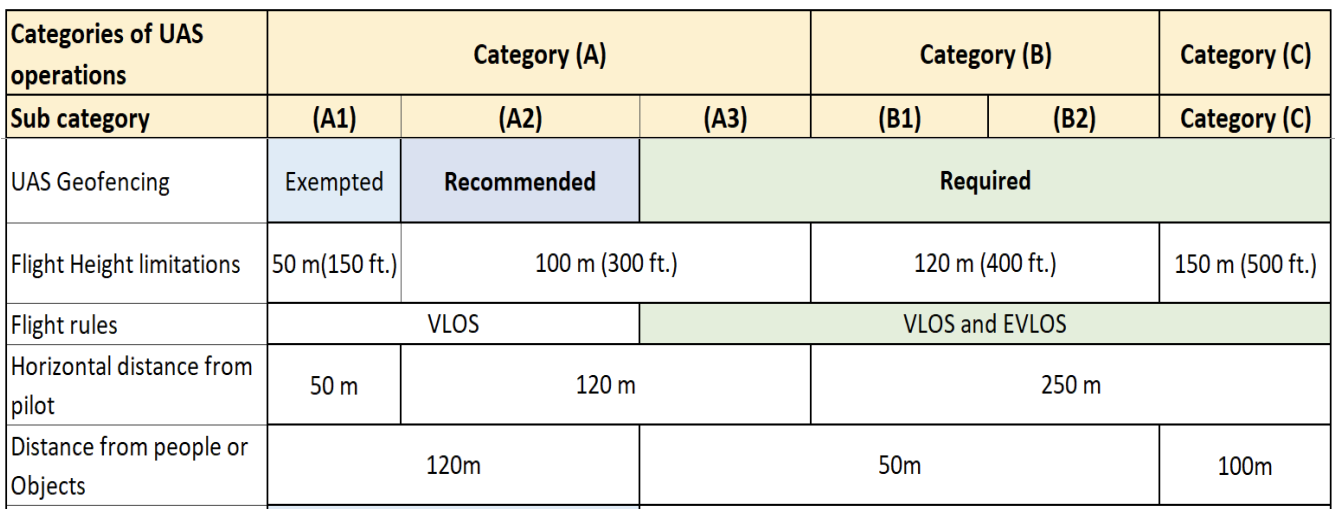
Changes related to an UOC or validation of a foreign UOC or equivalent
A. Any change affecting:
(1) The scope of the UOC or terms of approval of an operator;
(2) The special approvals defined in item 9; or
(3) Any of the elements of the operator’s management system shall require prior approval by the Competent Authority.
B. For any changes requiring prior approval in accordance with this REGULATION, the operator shall apply for and obtain an approval issued by Kuwait DGCA. The application shall be submitted before any such change takes place to enable Kuwait DGCA to determine continued compliance with this regulation and to amend, if necessary, the UOC and related terms of approval attached to it. The operator shall provide Kuwait DGCA with any relevant documentation. The change shall only be implemented upon receipt of formal approval by Kuwait DGCA. The operator shall operate under the conditions prescribed by Kuwait DGCA during such changes, as applicable.
C. All changes not requiring prior approval shall be managed and notified to Kuwait DGCA as defined in the procedure approved by Kuwait DGCA.
Acceptable Means of Compliance (AMC) – Changes related to an UOC or validation of a foreign UOC or equivalent
A. Application Time Frames. The application for the amendment of an UOC should be submitted at least 30 days before the date of the intended changes:
a) In the case of a planned change of a nominated person, the operator should inform Kuwait DGCA at least 30 days before the date of the proposed change.
b) Unforeseen changes should be notified at the earliest opportunity, to enable Kuwait DGCA to determine continued compliance with the applicable requirements and to amend, if necessary, the UOC and related terms of approval.
Guidance Material (GM1) – Changes related to an UOC or validation of a foreign UOC or equivalent
A. Typical examples of changes that may affect the UOC or the terms of approval or the operator’s management system are listed below:
(1) the name of the operator;
(2) a change of legal entity;
(3) the operator’s principal place of business;
(4) the operator’s scope of activities;
(5) additional locations of the operator;
(6) the accountable manager;
(7) the operator’s documentation safety-related procedures; or
(8) the facilities.
B. Prior approval by Kuwait DGCA is required for any changes to the operator’s procedure describing how changes not requiring prior approval will be managed and notified to the Competent Authority.
C. Changes requiring prior approval may only be implemented upon receipt of formal approval by Kuwait DGCA.
Guidance Material (GM2) – Changes related to an UOC or validation of a foreign UOC or equivalent CHANGE OF NAME A change of name requires the operator to submit a new application as a matter of urgency. Where this is the only change to report, the new application can be accompanied by a copy of the documentation previously submitted to Kuwait DGCA under the previous name, as a means of demonstrating how the operator complies with the applicable requirements.
Continued validity of an UOC or validation of a foreign UOC or equivalent
A. The UOC shall remain valid for a period up to two years subject to:
(1) The operator remaining in compliance with the relevant requirements of this regulation and other applicable regulations or publications, taking into account the provisions related to the handling of findings as specified under item 13 (Findings);
(2) Kuwait DGCA being granted access to the operator as defined in item 12 (Access) to determine continued compliance with the relevant requirements of this regulation; and
(3) The UOC not being surrendered or revoked. B. Upon revocation or surrender the UOC shall be returned to Kuwait DGCA without delay.
Access
For the purpose of determining compliance with the relevant requirements of this regulation, the operator shall grant access at any time to any facility, equipment, document, records, data, procedures or any other material relevant to its activity subject to certification whether it is contracted or not, to any person authorized by Kuwait DGCA.
Findings
After receipt of notification of findings, the operator shall:
(a) Identify the root cause of the non-compliance;
(b) Define a corrective action plan; and
(c) Demonstrate corrective action implementation to the satisfaction of Kuwait DGCA within the period agreed upon.
Acceptable means of compliance (AMC) Findings
The corrective action plan defined by the operator should address the effects of the non-compliance, as well as its root cause.
Guidance Material (GM) Findings
a) Preventive action is the action to eliminate the cause of a potential noncompliance or other undesirable potential situation.
b) Corrective action is the action to eliminate or mitigate the root cause(s) and prevent recurrence of an existing detected non-compliance or other undesirable condition or situation. Proper determination of the root cause is crucial for defining effective corrective actions to prevent re-occurrence.
c) Correction is the action to eliminate a detected non-compliance.
Immediate reaction to a safety problem
The operator shall implement any safety measures mandated by Kuwait DGCA.
Occurrence reporting
(a) The operator shall report to Kuwait DGCA and other agencies (GM1) Occurrence reporting) any accident, serious incident and occurrence. The report shall be submitted immediately in the event of an accident.
(b) Without prejudice to point (a), the operator shall report to Kuwait DGCA and to the manufacturer of the UAS any incident, malfunction, technical defect, exceeding of technical limitations or occurrence that would highlight inaccurate, incomplete or ambiguous information contained in the manufacturer’s documentation or other irregular circumstance that has or may have endangered the safe operation of the UAS and that has not resulted in an accident or serious incident.
(c) Reports referred in paragraphs (a) and (b) shall be made in a form and manners established by Kuwait DGCA and contain all pertinent information about the condition known to the operator.
(d) Reports shall be made as soon as practicable, but in any case within 72 hours of the operator identifying the condition to which the report relates, unless exceptional circumstances prevent this.
(e) Where relevant, the operator shall produce a follow-up report to provide details of actions it intends to take to prevent similar occurrences in the future, as soon as these actions have been identified. This report shall be produced in a form and manner established by Kuwait DGCA.
Acceptable means of compliance (AMC) Occurrence reporting
1) Whenever an UAS accident occurs or an incident jeopardizing public safety is noticed, the event should be reported to Kuwait DGCA.
2) Reports should be submitted using the DGCA MOR form (DGCA/KAORS/99) available on Kuwait DGCA web site (https://kcasr.dgca.gov.kw/aviation-safety-department/formsapplications//)
Guidance Material (GM1) – Occurrence reporting OTHER AGENCIES The term agency includes UAS manufacturer or any other law enforcement agencies e.g. Kuwait Ministry of Interior (MOI).
Guidance Material (GM2) Occurrence reporting – Below is a non-exhaustive list of incidents/accidents involving UAS operations to be reported:
(a) Crashes causing injury or fatality to a person or damage property
(b) Near-miss with a manned aircraft or other UAS.
(c) Collision with a building or structure
(d) Operation without appropriate Kuwait DGCA’s approval
(e) Operations causing public nuisance
(f) Penetration of a Non-Flying zone without Kuwait DGCA’s approval
SUBPART A: UAS OPERATOR MANAGEMENT SYSTEM
1. MANAGEMENT SYSTEM
A. T he operator shall establish, implement and maintain a management system that includes:
(1) Clearly defined lines of responsibility and accountability throughout the operator, including a direct safety accountability of the Accountable Manager;
(2) The identification of aviation safety and security hazards entailed by the activities of the operator, their evaluation and the management of associated risks, including taking actions to mitigate the risk and verify their effectiveness;
(3) Documentation of all management system key processes, including a process for making personnel aware of their responsibilities and the procedure for amending this documentation; and
(4) Maintaining personnel trained and competent to perform their tasks.
B. The management system shall correspond to the size of the operator and the nature and complexity of its activities/operations, taking into account the hazards and associated risks inherent in these activities. Optional Material for Advanced Management system
Acceptable means of compliance (AMC1) – Advanced Management system
A. Safety or Security risk management may be performed using hazard checklists or similar risk management tools or processes, which are integrated into the activities of the operator. Within the operator, responsibilities should be identified for hazard identification, risk assessment and mitigation and a description of the functions and the responsibilities of involved personnel should be contained in the Operations Manual.
B. The operator should manage safety and security risks related to a change. The management of change should be a documented process to identify external and internal change that may have an adverse effect on safety or security. It should make use of the operator’s existing hazard identification, risk assessment and mitigation processes.
C. The Operations Manual should include a commitment to improve towards the highest safety and security standards, comply with all applicable legal requirements, meet all applicable standards, consider best practices and provide appropriate resources. Continuous improvement should be achieved through:
1) proactive and reactive evaluations of facilities, equipment, documentation and procedures through audits and surveys;
2) proactive evaluation of individuals’ performance to verify the fulfillment of their responsibilities; and
3) reactive evaluations to verify the effectiveness of the system for control and mitigation of risk.
D. The operator should, in cooperation with other stakeholders (if any), develop, coordinate and maintain emergency procedures that ensure orderly and safe transition from normal to emergency operations and return to normal operations. The procedures should provide the actions to be taken by the operator or specified individuals in an emergency and should reflect the size, nature and complexity of the activities/operations performed by the operator. Emergency procedures should ensure:
1) an orderly and safe transition from normal to emergency operations;
2) safe continuation of operations or return to normal operations as soon as practicable; and
3) coordination with the emergency response plans of other organizations, where appropriate.
Acceptable means of compliance (AMC2) Advanced Management system
A. Management System Documentation. The operator’s management system documentation should at least include the following information:
(1) A statement signed by the Accountable Manager to confirm that the operator will continuously work in accordance with the applicable requirements and the operator’s documentation, as required by;
(2) The operator’s scope of activities;
(3) An operator chart showing the lines of responsibility between any persons involved in the organization;
(4) The operator shall have facilities allowing the performance and management of all planned tasks and activities in accordance with the applicable requirements.
(5) Procedures specifying how the operator ensures compliance with the applicable requirements;
(6) The amendment procedure for the operator’s management system documentation.
B. The operator’s management system documentation may be included in a separate manual or in the operation manual
Guidance Material (GM1) Advanced Management system
The management system of an operator should aim at achievement the following functions.
1) monitor compliance of the operator with the relevant requirements including a feedback system of findings to the Accountable Manager to ensure effective implementation of corrective actions as necessary;
2) facilitate hazard identification, risk analysis and management;
3) define and monitor the timely implementation of actions taken to mitigate risks;
4) ensure maintenance of safety management documentation;
5) ensure that there is safety management training available and that it meets acceptable standards;
6) initiate, conduct and follow-up of internal occurrence/accident investigations; and,
7) ensure that appropriate resources are allocated to achieve an acceptable safety performance.
Guidance Material (GM2) Advanced Management system
A. Hazard identification processes: Reactive and proactive approaches for hazard identification should be the formal means of collecting, recording, analyzing, acting on and generating feedback about hazards and the associated risks that affect the safety of the operational activities of the operator.
B. Risk assessment and mitigation processes: A formal risk management process should be developed and maintained that ensures analysis (in terms of likelihood and severity of occurrence), assessment (in terms of tolerability) and control (in terms of mitigation) of risks to an acceptable level.
C. Internal safety investigation: The scope of internal safety investigations should extend beyond the scope of occurrences required to be reported to Kuwait DGCA. The overall purpose of the scheme is to use reported information to improve the level of safety performance of the operator and not to attribute blame. The objectives of the scheme are to:
(1) enable an assessment to be made of the safety implications of each relevant incident and accident, including previous similar occurrences, so that any necessary action can be initiated; and
(2) ensure that knowledge of relevant incidents and accidents is disseminated, so that other persons and operators may learn from them.; and
(3) ensure the overall monitoring function of the operator and it is complementary to the normal day-to-day procedures and ‘control’ systems since it is a tool that assists in identifying instances where routine procedures have failed.
D. The compliance monitoring function: Maybe performed by audits and inspections and conducted by and in accordance with procedure acceptable to Kuwait DGCA.
Guidance Material (GM3) Advanced Management system
Risk Management of Operations.
GENERAL – OPERATOR’S RESPONSIBILITIES
A. The operator is responsible for the safety of its operations, including within an area with known or forecast adverse weather conditions or within an area where other known hazards (e.g. hijack, spoofing) may affected a safe operation.
B. The operator should complete this assessment of risks as part of its management system before initiating operations into affected airspace.
C. This process is intended to ensure the operator takes account of the likely accuracy and quality of the information sources it uses in its management system and to demonstrate its own competence and capability to interpret data from different sources to achieve the necessary level of data integrity reliably and correctly resolve any conflicts among data sources that may arise.
D. The operator’s safety risk assessment should take into account all relevant data including data from the manufacturer of the UAS regarding the susceptibility of the UAS they operate to adverse weather conditions or other threat and the
E. Related pre-flight, in-flight and post-flight precautions to be observed by the operator.
F. The operator should ensure that personnel required to be familiar with the details of the safety risk assessments receives all relevant information (both pre-flight and in-flight) to be in a position to apply appropriate mitigation measures as specified by the safety risk assessments.
UAS OPERATOR MANAGEMENT SYSTEM OPERATION IN AIRSPACE WITH KNOWN OR FORECAST ADVERSE WEATHER CONDITIONS
Procedures
A. The operator should have documented procedures for the management of operations into airspace with known or forecast adverse weather conditions.
B. These procedures should ensure that, at all times, operations remain within the accepted safety boundaries as established during the safety risk assessment allowing for any variations in information sources, equipment, operational experience or organization. Procedures should include all safety-related personnel such that they are in a position to evaluate correctly the risk of flights into airspace and to plan accordingly. The operator should retain sufficient qualified and competent staff to generate well supported operational risk management decisions an d ensure that their staffs are appropriately trained and competent.
Weather information and operator’s potential response.
Before and during operations, information valuable to the operator is generated by meteorology service. The operator’s risk assessment and mitigating actions need to take account of, and respond appropriately to, the information likely to be available during each phase of the flight. A typical operator’s response may consist of the following:
C. The operator should have in place a robust mechanism for ensuring that it is constantly vigilant for any alerts of adverse weather relevant to its operations. The staff involved need to understand the threat to safe operations that such alerts represent.
D. Given the likely uncertainty regarding the status of the adverse weather during the early stages of the flight, the operator’s procedures should include a requirement for crew members to initiate re-routes to avoid the affected airspace.
E. The operator should ensure that flights are planned to remain clear of the affected areas and that consideration is given to available operating sites and fuel/battery autonomy requirements.
F. It is expected that the following initial actions will be taken by the operator:
(1) determine if any UAS in flight could be affected, alert the crew member and provide advice on re-routing and available operating sites as required;
(2) for flight departures, brief crew member and revise flight and fuel/battery autonomy planning in accordance with the safety risk assessment;
(3) alert crew member and operations staff to the need for increased monitoring of information;
(4) initiate the gathering of all data relevant to determining the risk; and
(5) apply mitigations identified in the safety risk assessment.
G. Given the dynamic nature of the weather, the operator should ensure that the situation is monitored closely, and operations adjusted to suit changing conditions.
Safety risk assessment
The issue of intended flight into airspace affected with known or forecast adverse weather conditions, the process should involve the following:
(1) Identifying the hazards: The main hazard is the airspace affected by adverse weather, and whose characteristics are harmful to the operation of the UAS. Nevertheless, it might not be the only hazard and therefore the operator should consider additional hazards which could have an adverse effect on the UAS structure or performance.
(2) The operator should develop its own list of specific hazards taking into account its specific UAS, experience, knowledge and type of operation, and any other relevant data stemming from previous flights (e.g. flying close to structure, Power lines, etc…).
(3) Considering the severity and consequences of the hazard occurring (i.e. the nature and actual level of damage expected to be inflicted on the particular UAS from exposure to that adverse weather).
(4) Evaluating the likelihood of encountering adverse weather with characteristics harmful to the safe operation of the aircraft. For each specific hazard within the generic hazard, the likelihood of adverse consequences should be assessed, either qualitatively or quantitatively.
(5) Determining whether the consequent risk is acceptable and within the operator’s risk performance criteria. The safety risks should be classified as acceptable or unacceptable. The assessment of tolerability will be subjective, based on qualitative data and expert judgement, until specific quantitative data are available.
(6) Taking action to reduce the safety risk to a level that is acceptable to the operator’s management. Appropriate mitigation for each unacceptable risk identified should then be considered to reduce the risk to a level acceptable to the operator’s management.
Procedures to be considered when identifying possible mitigations actions.
When conducting a safety risk assessment, the operator should consider the following non- exhaustive list of procedures and processes as mitigation:
A. UAS manufacturer: Obtaining advice from the manufacturer of the UAS concerning operations in airspace with known or forecast adverse weather conditions. This advice should set out:
1) the features of the UAS that are susceptible to effects arisen from adverse weather conditions;
2) the nature and severity of these effects;
3) the effect of adverse weather on operations in airspace affected by adverse weather conditions, including the effect on take-off and landing performance; and
4) the related pre-flight, in-flight and post-flight precautions to be observed by the operator.
B. Provision of enhanced flight watch
This should ensure:
1) close and continuous monitoring of meteorology information and other relevant information;
2) communication of the latest information to crew members and personnel responsible for the management and the supervision of the operations in a timely fashion.
C. Flight planning: should allow flexibility of the process to allow replanning at short notice should conditions change and the probability of being affected by the adverse weather condition in the airspace to be traversed.
D. Routing policy: Parameters to evaluate and take account of:
1) the shortest period in and over the concerned airspace;
2) the hazards associated with flying over the concerned area;
E. Diversion policy: Parameters to evaluate and take account of:
1) maximum allowed distance from a suitable operating site;
2) availability of operating sites outside the concerned airspace;
3) landing policy after adverse weather conditions encounter.
F. Standard operating procedures: Crew Member training to ensure they are familiar with normal and abnormal operating procedures and particularly any changes regarding but not limited to:
1) pre-flight planning;
2) in-flight monitoring of airspace affected by adverse weather conditions areas and avoidance procedures;
3) diversion; procedures to be followed if such situation is encountered;
4) operations to/from operating sites affected by adverse weather.
Guidance Material (GM4) Advanced Management system
Safety & Security Risk Assessment – Risk Register. (Table 4) The results of the assessment of the potential adverse consequences or outcome of each hazard may be recorded by the operator in a risk register, an example of which is provided below.
Table 4

Acceptable means of compliance (AMC3)
Advanced Management system Training and Communication on Safety
A. Training
(1) All personnel should receive safety training as appropriate for their safety responsibilities.
(2) Adequate records of all safety training provided should be kept.
B. Communication
(1) The operator should establish communication about safety matters that:
(i) Ensures that all personnel are aware of the safety management activities as appropriate for their safety responsibilities;
(ii) conveys safety critical information, especially relating to assessed risks and analyzed hazards;
(iii) explains why particular actions are taken; and
(iv) explains why safety procedures are introduced or changed.
(2) Regular meetings with personnel where information, actions and procedures are discussed may be used to communicate safety matters.
Guidance Material (GM5) Advanced Management system
TRAINING AND COMMUNICATION ON SAFETY
The safety training program may consist of self-instruction via the media (newsletters, flight safety magazines), classroom training, e-learning or similar training provided by training service providers.
Personnel requirements
(a) The operator shall appoint an Accountable Manager, who has the authority for ensuring that all activities can be financed and carried out in accordance with the applicable requirements. The Accountable Manager shall be responsible for establishing and maintaining an effective management system as required by this regulation.
(b) The operator shall have sufficient qualified personnel for the planned tasks and activities to be performed in accordance with the applicable requirements.
(c) The operator shall maintain appropriate experience, qualification and training records to show compliance with point (b).
(d) The operator shall ensure that all personnel are aware of the rules and procedures relevant to the exercise of their duties.
Acceptable means of compliance (AMC1) Personal Requirements
The capacity of an individual to meet his/her responsibilities should primarily be dependent upon the scale of the operation. However, the complexity of the operator or of the operation may prevent, or limit, combinations of role and/or responsibilities which may be acceptable in other circumstances. The operator should demonstrate adequacy and competency of all personnel assigned to, or directly involved in, operations and ensure that they are:
1) properly trained;
2) have demonstrated their capabilities in the performance of their assigned duties; and
3) aware of their responsibilities and the relationship of their duties to the operation as a whole; and;
4) sufficient t o ensure continuity of supervision in the absence of nominated persons.
Acceptable means of compliance (AMC2) Personal Requirements
A. Qualification of Personal – All All personnel should be expected to possess:
(1) The knowledge of the flights conducted by the operator.
(2) Practical experience and expertise in the application o f aviation safety standards and safe operating practices in their respective areas;
(3) Comprehensive knowledge of:
a) The applicable Kuwait DGCA safety regulations and any associated requirements and procedures;
b) The UOC holder’s operations specifications; and
c) The need for, and content of, the relevant parts of the UOC holder’s Operations Manual;
(4) Familiarity with management systems preferably in the area of aviation;
(5) Appropriate management experience, preferably in a comparable organization (for management personnel); and
(6) relevant work experience in this field.
B. Qualification of Personal – UAS Operating Crew
In addition to above, UAS Operating Crews should be authorized to operate an UAS if they:
(1) Have been qualified by the UAS manufacturer or any recognized organization certified by the manufacturer (the organization should be acceptable to Kuwait DGCA);
(2) Hold a UAS license issued by a State recognized by Kuwait DGCA; or
(3) Hold an air academy certificate or training certificate from vender accepted by Kuwait DGCA; and
(4) Pass a test established by Kuwait DGCA.
C. The UAS Operating Crew should be able to demonstrate knowledge in the following subjects:
(1) Air Law
(2) Unmanned Aircraft General Knowledge
(3) General Navigation
(4) FlightPlanning
(5) Meteorology
(6) Operational Procedures
1. Areas of operations – Unless authorized by Kuwait DGCA, an operator shall ensure that no operation is undertaken:
(a) In a prohibited or restricted area;
(b) In a controlled airspace;
(c) In the vicinity of an aerodrome or heliport; and
(d) Outside the areas prescribed in the terms of approval of the UOC.
(e) In areas with buildings, power lines ..etc.
Guidance Material (GM1) Areas of operations – This includes any airspace above the territory of a foreign State. The areas authorized without approvals are those specified on Kuwait DGCA website.
Guidance Material (GM2) Area of operations – Request for segregated airspace should submit an application through Kuwait DGCA Special Airspace use request.
2. Insurance Requirements, and privacy and properties restrictions – The operator shall ensure that no operation:
(a) is undertaken unless covered for third-party liability as per established minimum insurance requirements;
(b) contravenes intentionally or unintentionally the privacy of any natural or legal person; and
(c) is conducted to intentionally or unintentionally damage someone’s property.
Acceptable means of compliance (AMC) Insurance Requirements, and privacy and properties restrictions – The following items should be covered in the Certificate of insurance:
a) policy Number;
b) Insurer;
c) Details of UAS;
d) Period of insurance;
e) Interest insured;
f) KD 20,000 combined single limit in respect of property damage and bodily injury and/or death any one accident or series of accidents arising out of the same occurrence;
g) Geographical Area within Kuwait; and
h) Conditions.
Guidance Material (GM) Insurance Requirements, and privacy and properties restrictions – The operator should obtain the necessary agreement from the owner(s) of a property that the UAS will overfly or fly nearby. In the case of a public area or residential area, approval from the Ministry of Interior (MOI) Shall be obtained.
3. Aviation security requirements
The operator shall ensure compliance with any security requirement mandated by Kuwait DGCA or any other agencies and in particular:
A. No Dangerous Goods (DGs) shall be transported by air unless permitted by Kuwait DGCA.
B. No flight shall commence unless the operator shall ensure it holds a valid security clearance.
C. No UAS equipped with photographic apparatus shall undertake flight unless a security approval has been granted by Kuwait DGCA/ Ministry of Interior (MOI).
D. Drone operations or use outside the scope of this regulation shall be considered unlawful interference act against civil aviation.
4. Conduct of flights
The operator shall not undertake a flight unless:
A. It holds the required approvals from Kuwait DGCA.
B. The operator shall determine and maintain a defined minimum safety distance while operating close to person and fixed or mobile objects. The minimum safety distance shall not be less than 50 meters unless authorized as per item 9 (Special Approvals).
C. The operator shall ensure that all components of the UAS are in working order and in accordance with the manufacturer’s user manual and Kuwait DGCA’s specifications
D. The Operator shall ensure that the UAS Crew Member while, operating an UAS:
(1) does not interfere with anyATC;
(2) does not drop any object or article attached to the UAS; and
(3) gives way all the time to other aircraft and lands his UAS whenever he hears or sights another aircraft in the vicinity.
Guidance Material (GM) Conduct of flights – The safety risk assessment to prove compliance required by SUBPART A Should facilitate the determination of the minimum distances for each intended operation. The term object may include: the object for which the flight is intended for; building, houses, mobile assets, urban furniture (e.g. electrical poles, or others installations).
Attachments
1. Unmanned Aircraft Systems Reference (Table 5)
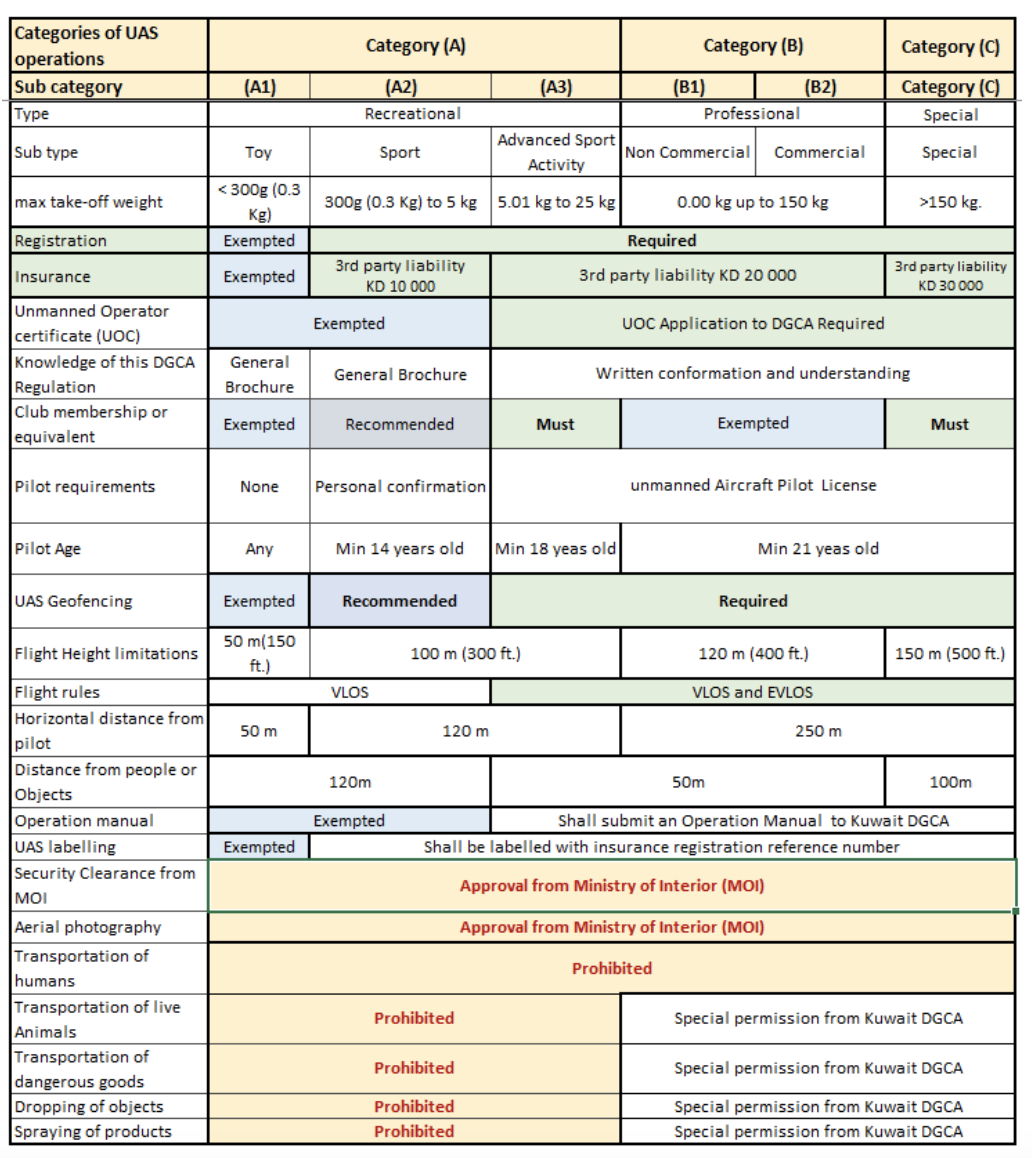
2. Recreational Operations registration UAS Category (A) Form XXX1
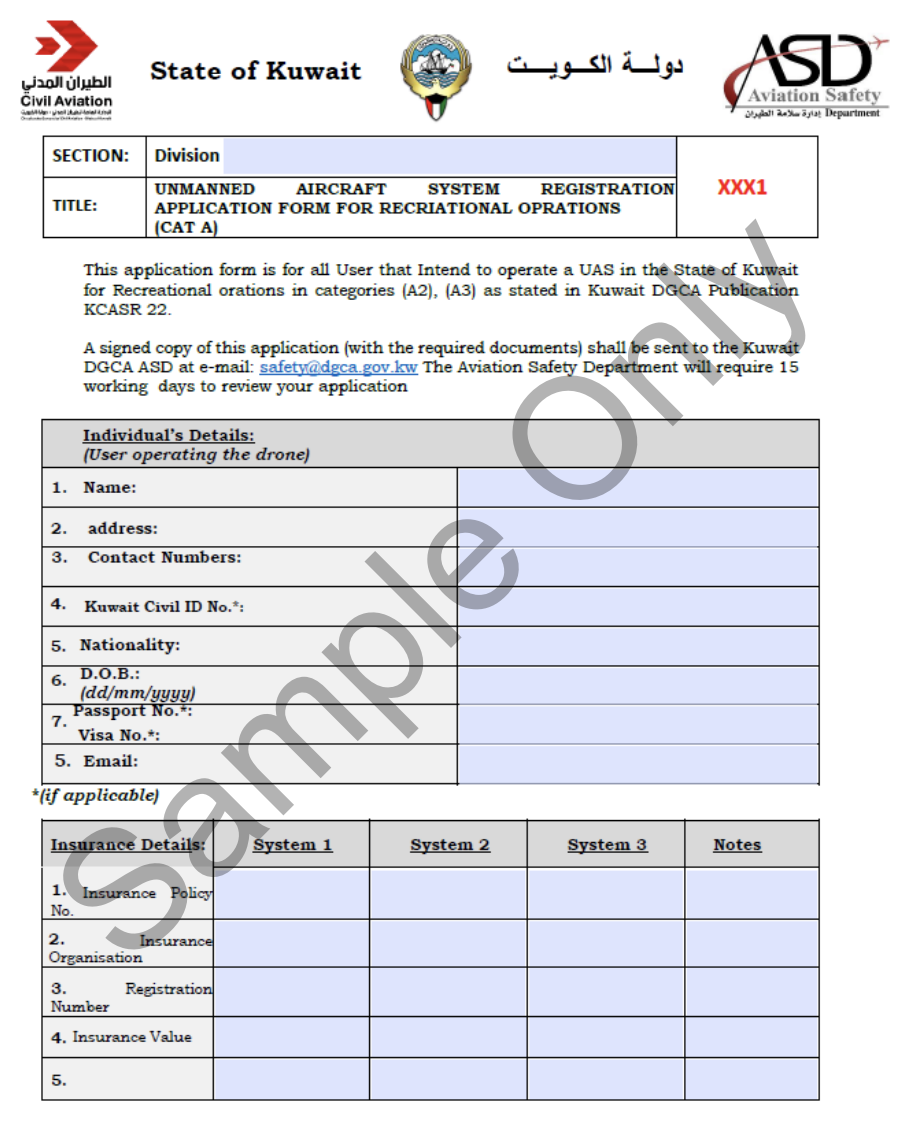


3. Professional Operations registration UAS Category (B) Form xxx2
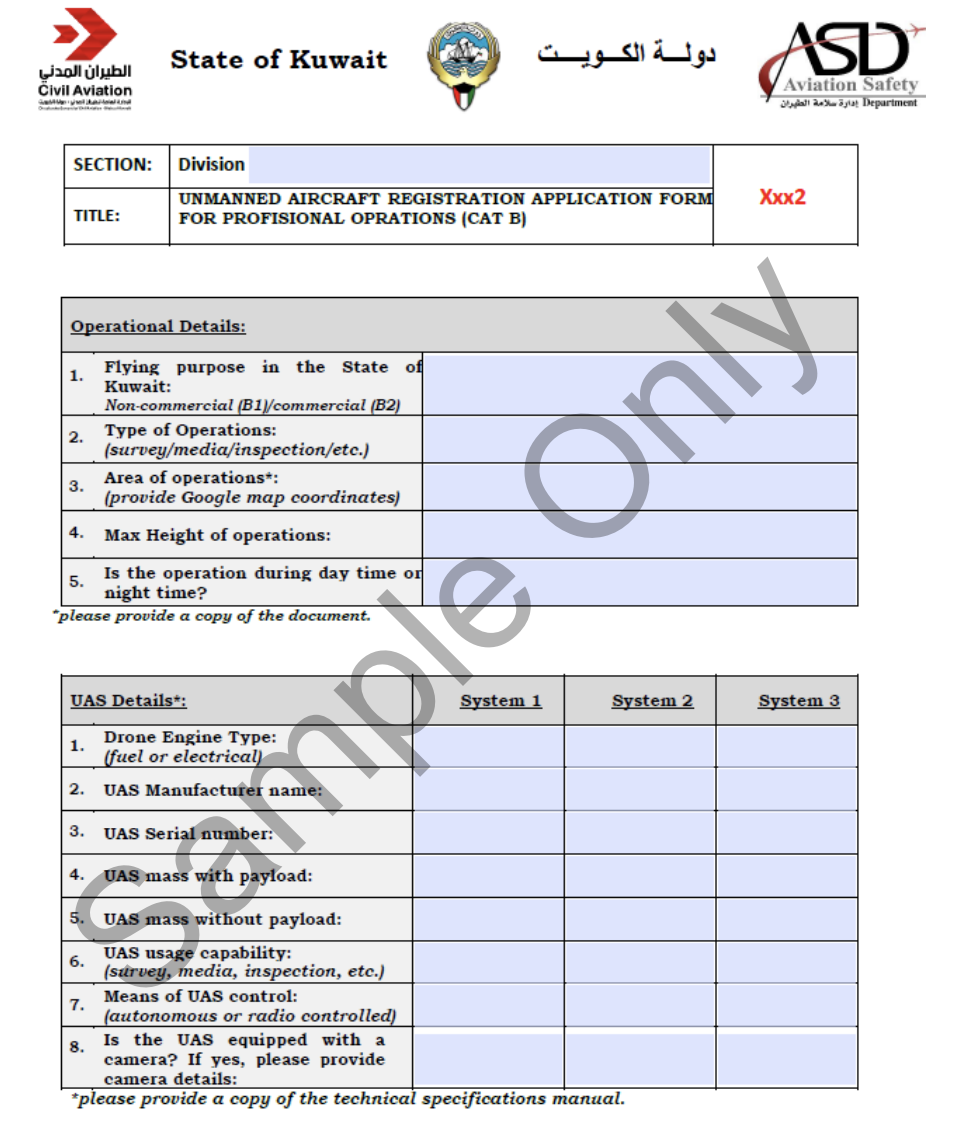
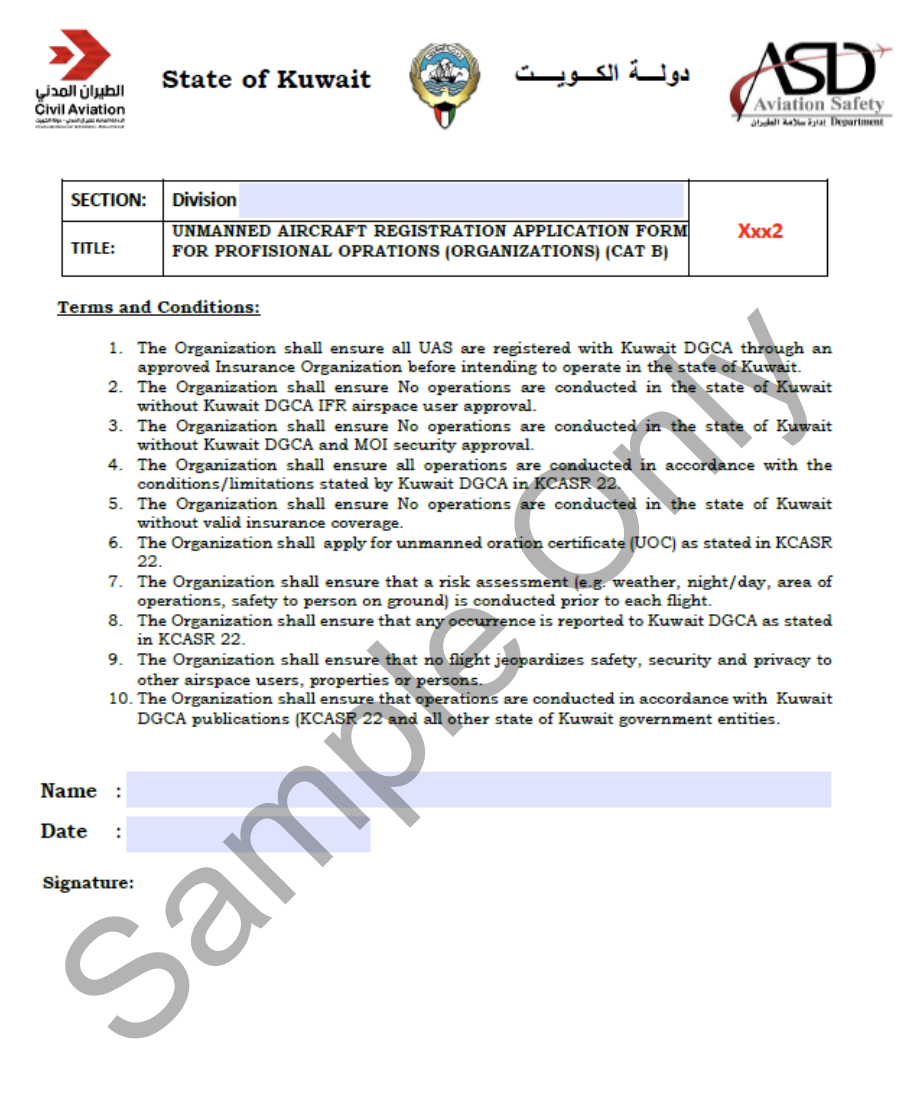
4. Special Operations registration UAS Category (C) Form xxx3
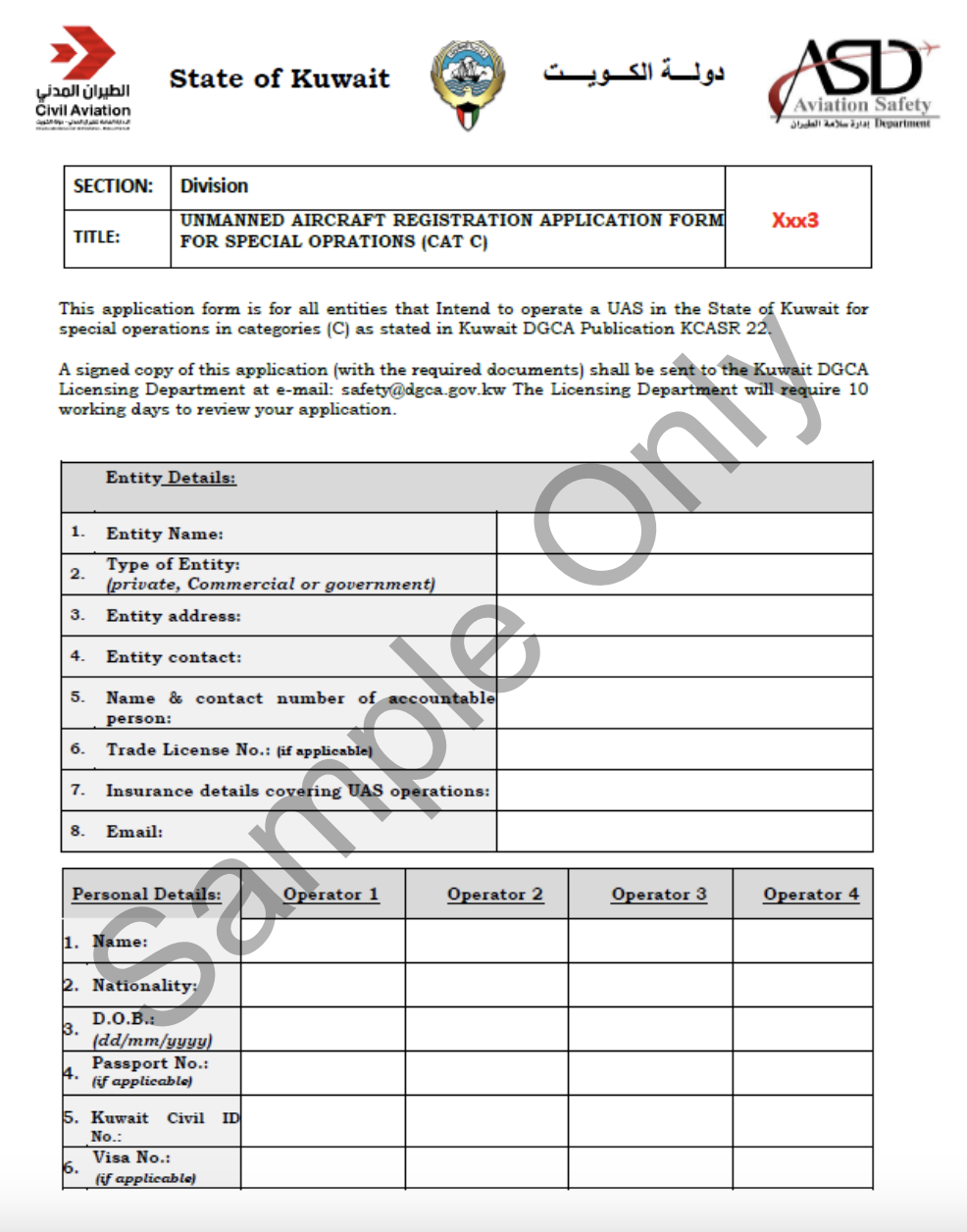
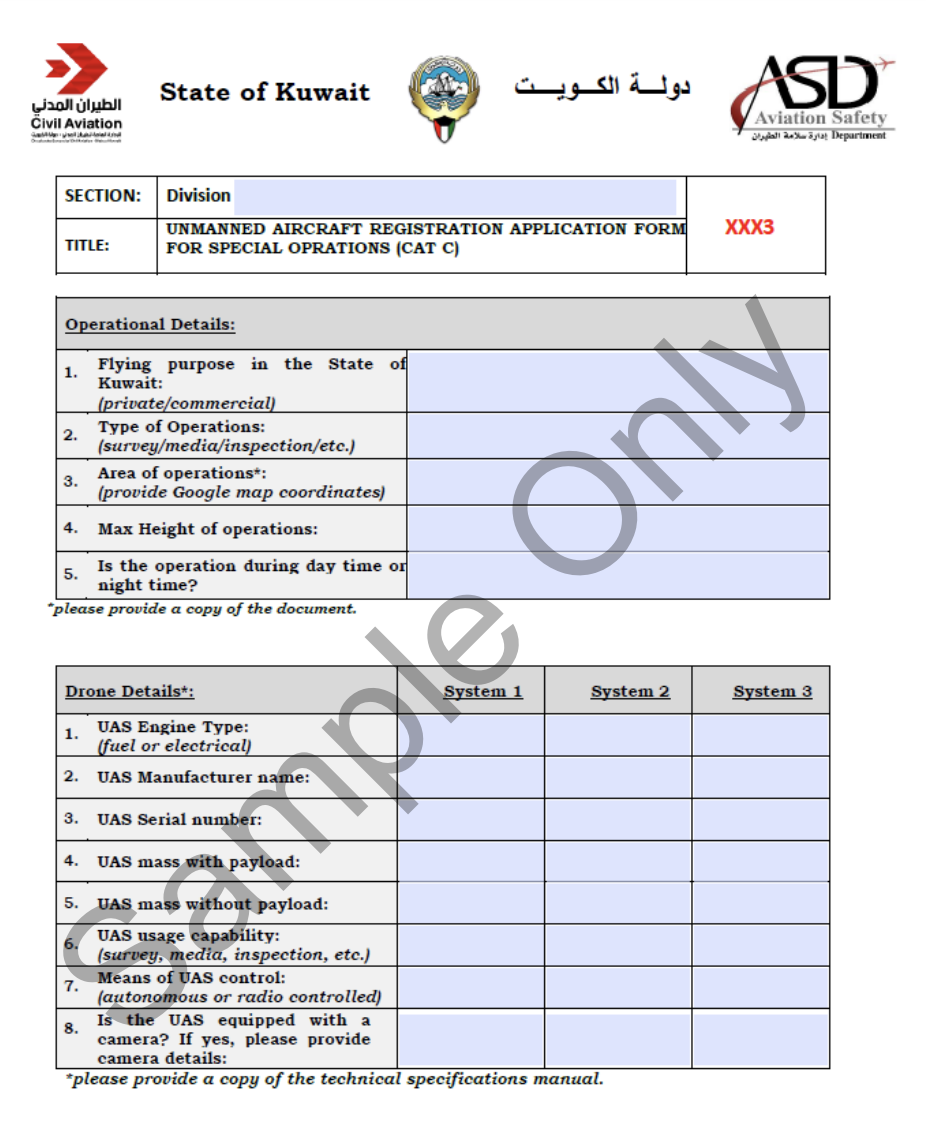
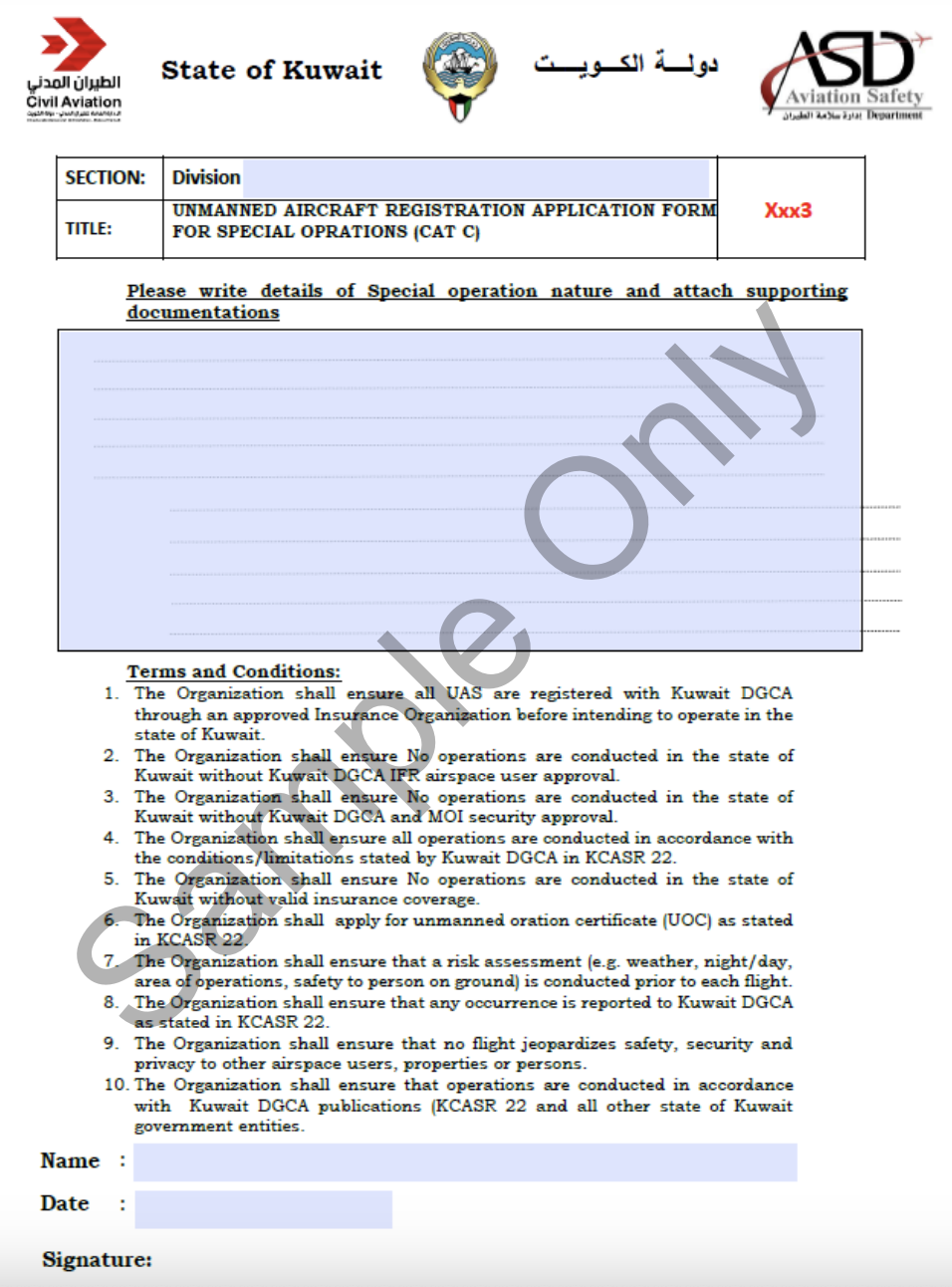
5. Application for Initial/Renewal of UOC, Form xxx4
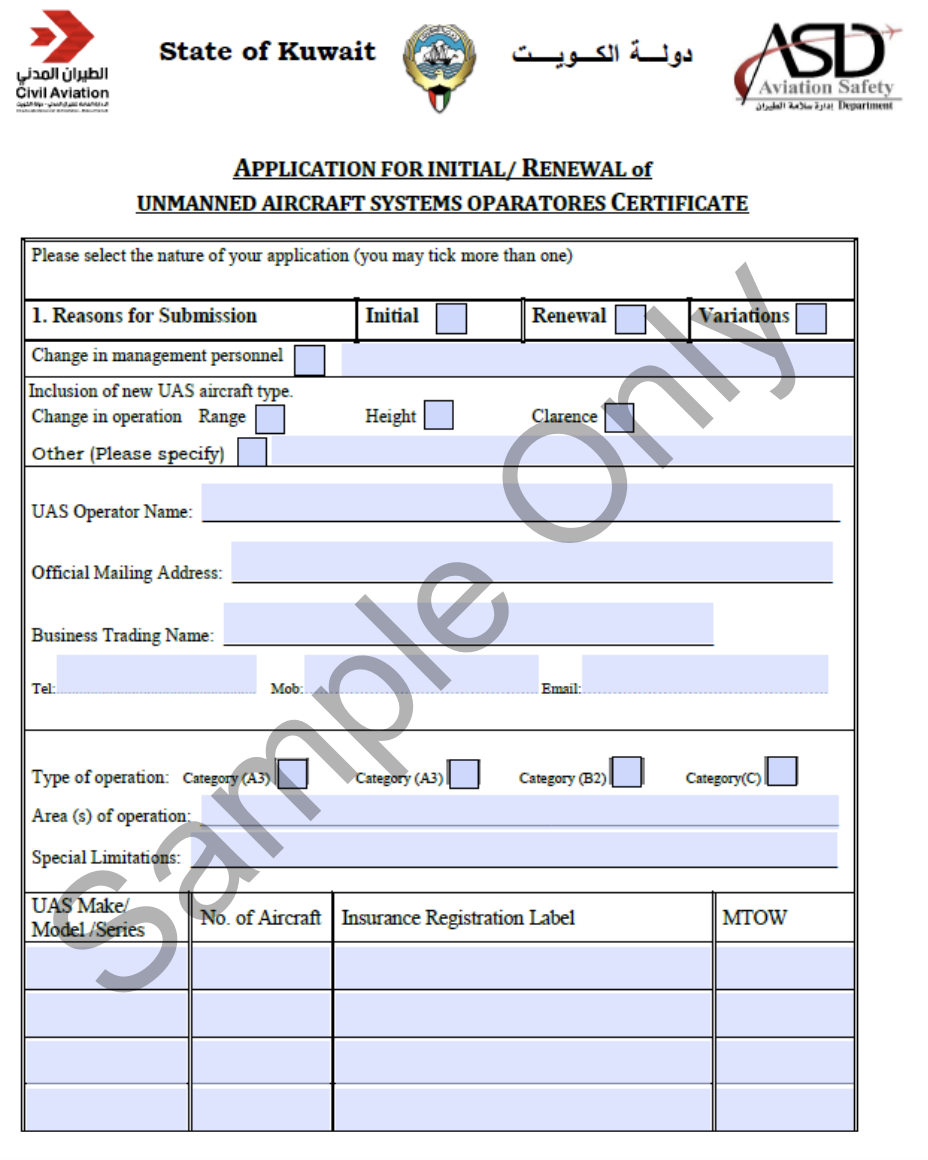
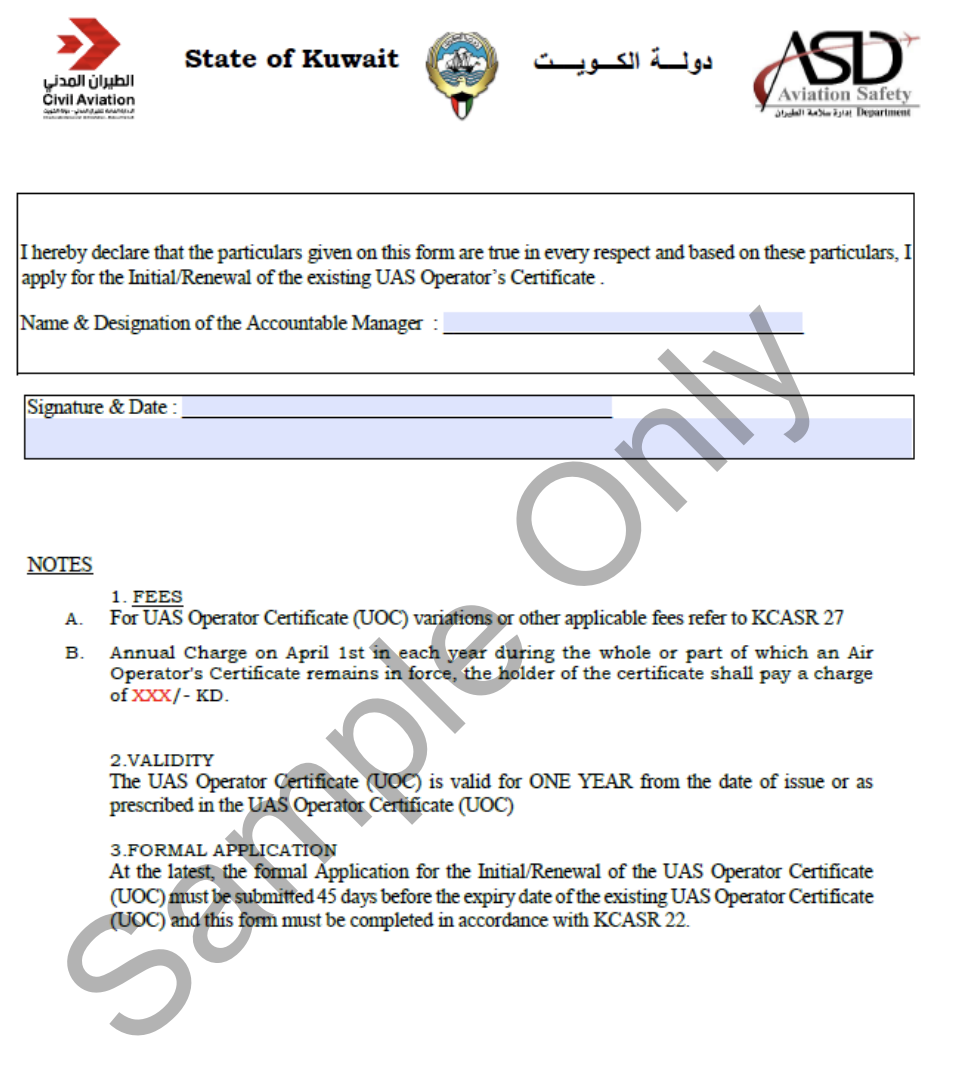
Application for Registration of Unmanned Aircraft System(UAS)
Application for Initial Renewal of Unmanned Aircraft systems Operators Certificate
Advanced Air Mobility (AAM)
Short Essay Questions
Question 1
You have been hired by a Drone Startup Company. Your boss has immediately assigned this job to you.
They need you to prepare a one-page memo detailing the legalities of using a drone to film at night the Kuwait Water Towers, pictured above.
They need you to mention any national laws and local ordinances.
They specifically want to know what airspace you will be operating in and whether or not you need an airspace authorization.
Does it matter whether or not you are a citizen of the country?
Lastly, there is a bonus for you if, as you scroll through this chapter, you find any typos or broken links!
Question 2
Do you need a certificate to fly UAS?
If so, how do you obtain one?
Are there fees associated with this?
If so, how much?
Question 3
May you operate beyond visual line of sight?
If so, what procedures must you follow?
Question 4
Does the country have UAM/AAM laws? If so, describe, citing the exact law.
Question 5
Are you aware of any new laws or policies not mentioned above? If so, describe, citing the exact law or policy.

